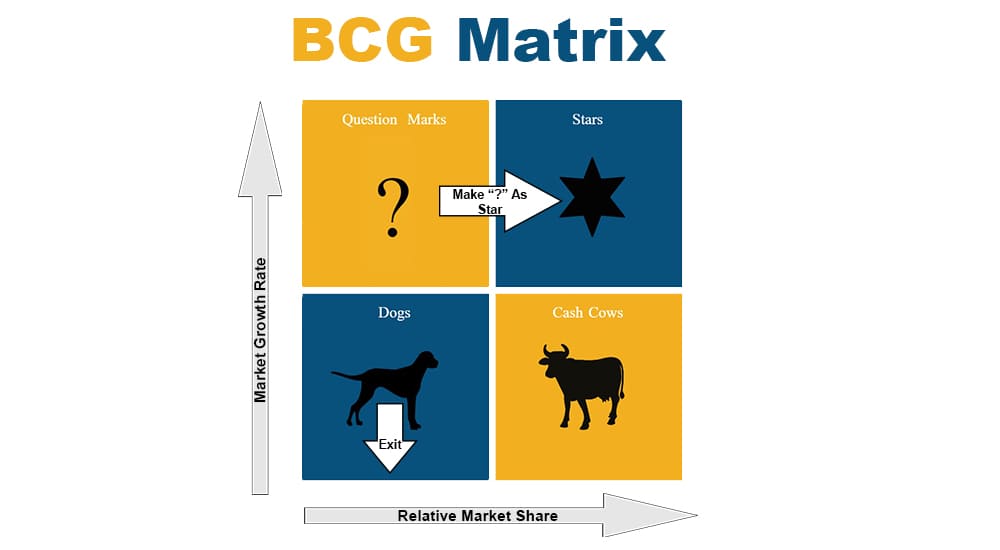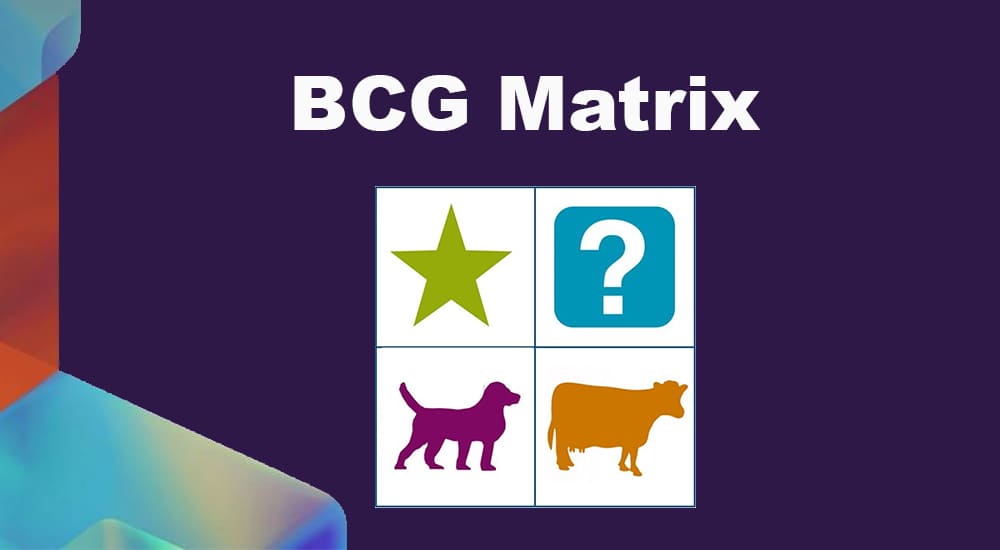The Boston Consulting Group (BCG) Matrix was introduced by Bruce Henderson in 1970. The BCG Matrix is also called the BCG Growth-Share Matrix and is one of the most popular portfolio planning tools. This matrix helps businesses analyze their portfolios under one table.
This matrix shows the organization’s products and services under different segments so they can decide which segment they should focus on and what part they should get rid of.
BCG Matrix

The horizontal axis of the BCG Matrix represents the market share of the product. More market share means the product or service has a better reach to customers than competitors.
The vertical axis represents the potential growth rate of a product in the market. The higher the growth rate, the higher the competition to stay relevant in the market.
The BCG Matrix has four quadrants:
- Question Marks – Products or services with high market growth but a low market share.
- Stars – Products or services with high market growth and a high market share.
- Dogs – Products or services with low market share and low growth.
- Cash Cows – Products or services with a high market share but a low market growth.
Let’s review each quadrant in detail.
Question Marks
Products or services in the question mark quadrant have a low market share, but the market is growing quickly and has the potential to grow further. The business must get funds from the cow segment to turn a question mark into a star (to increase the market share).
Ideal scenario: The business must attempt to turn the question mark segment into a star segment. Failing to do so can turn the question mark segment into a dog segment.
Stars
Products or services in the stars quadrant have a high market share, and the market has further growth potential. Businesses should get funds from cash cows and invest in this segment to increase their market share to stay competitive.
No investment in this segment will allow competitors to tap into the market.
As the markets mature, stars can become cash cows. Stars are prized possessions and are at the top of the portfolio.
Dogs
Products or services in the dogs’ quadrant have a low market share with no potential growth. The market is saturated with existing competitors (stars or cash cows), and chances are low to grow or beat the competition.
For example, consider the IRCTC (Indian Railways Catering and Tourism Services) case. A vendor was supplying food a couple of years back. This service was a cash cow segment for the supplier, there was no scope for further growth, but they had a large market share. The government changed the rules and decided to own the food segment.
The vendor moved from the cash cow to the dog quadrant. There is no further growth, the market share is gone, and they can never become stars.
Businesses should move away from the dogs’ quadrant instead of further investment. You can see an exit arrow in the dog quadrant of the BCG Matrix.
The business may need to retain some products instead of phasing them out as they complement existing products or are used for a competitive purpose.
For example, let’s say one business unit of an organization was producing sugar. Back in the 1970s, this was their primary business of generating sugar. Let’s assume the market shifted from consuming sugar to jaggery, and the organization has no plants for the jaggery generation.
As of today, the business revenues are sugar (10%), alcohol (20%), and chocolate and confectionery (70%). The company cannot phase out sugar as it is needed to produce chocolate and confectionery products.
Cash Cows
Products or services in the cash cows quadrant have a high market share and no scope for further growth.
Consider an example of ITC; 45% of their revenue comes from cigarettes. ITC is the largest cigarette firm in India, and they have no further growth potential. So, ITC will milk the maximum amount of cash in this segment and invest in other ventures to stay in business. Cash flows generated in cash cow segments are high, and finance can “question mark” and “star” quadrants.
ITC has already invested significantly in the cigarette segment and does not need further investments to maintain its position.
Consider another example of Indian Railways. They have invested heavily in the infrastructure, they don’t need to invest further to stay competitive, and the growth options in this segment are limited.
Another example is Dubai, they have huge oil reserves, and this is a cow segment for the country. The country doesn’t require investment to stay competitive in this segment, so they milk the money (from the cow segment – oil) and focus on other segments like tourism and infrastructure to attract businesses.
While financing other segments by taking funds from the cow segment, ensure the cow is not killed.
Consider the scenario of an insurance corporation (cow quadrant) owned by the government. The government takes money from the cow quadrant and invests in infrastructure, roads, etc. If the government bails out the loss-making banks by taking money from the insurance corporation, it might kill the cow, so such actions should be avoided.
BCG Matrix Examples
Consider the example of a PC. Xerox Alto first developed a GUI-based PC, and then multiple companies developed different operating systems like Mac, Windows, etc.
In this example, market share and growth rate were initially low (dogs) as the audience felt IBM’s OS was better, and Mac was very expensive. Then Apple updated the Mac, and suddenly it became more attractive. Many businesses felt high chances of growth and decided to invest.
Though market share was low for GUI-based PCs because of low sales, the potential was high, so competition started building up. At this stage, the product was in the question mark quadrant.
Apple invested in Mac and converted the question mark to star. Microsoft copied the Mac GUI and launched Windows. Then the competition became intense, and Apple’s Mac became a star in the BCG Matrix (instead of a cash cow) because the competition in the market was high, and Apple invested a lot in R&D and new developments to keep its market share higher. This is one such example of a BCG Matrix.
For Apple, Mac is a cash cow, iPods are dogs, iPhones are stars, and Apple TV is a question mark.
Let’s consider another example: Amazon. Amazon started by selling books. The Amazon BCG Matrix would look like this:
- Amazon Alexa is a dog
- Amazon’s live streaming is a question mark
- Amazon’s AWS is a star (with competition from Microsoft’s Azure and other services)
Let’s consider another example of ITC, which is involved in different segments like cigarettes, FMCG, agri-business, and the hotel business. ITC’s gross revenues are as below:
- From cigarettes, the company gets 45% of its revenue
- From FMCG (excluding cigarettes), the company gets 22% of its revenue
- From agri-business, the company gets 13% of its revenue
- From the hotel business, the company gets 3% of its revenue
You can say that cigarettes are the cash cow, as this segment provides 45% of its revenue. They have a high market share but low market growth as there is no further growth potential.
The hotel business is in the dog quadrant, so the company should plan to exit as early as possible.
Agri-business is the question mark in the BCG Matrix. The market share is low but has high market growth, and the company can plan to convert this question mark into a star (by increasing the market share). Not focusing on question marks can turn them into dogs. They can get funds milked from the cash cows (cigarettes).
FMCG is a star in the BCG Matrix because they have a good market share in high competition. To stay in the competition, ITC should invest more money to stay competitive.
BCG Matrix Limitations
- The BCG Matrix classifies a business as low and high and avoids medium businesses.
- A high market share doesn’t always lead to high profits. Consider the example of Amazon India. Amazon has the highest market share, but the profits are negative (because of high investment and promotion), which should also be considered. So, this model doesn’t give you accuracy in profits.
- In the BCG Matrix, the dog segment should be phased out. Many times these products complement other products and are necessary for competitiveness. In this case, this quadrant can give incorrect results.
- The market has no clear definition in a BCG Matrix. For example, Samsung competes only in the smartphone segment, whereas other brands compete in smartphones and basic phone segments. This makes comparisons difficult.
- Getting global data on market share and market growth is quite challenging.
- This framework has only four independent quadrants. Some additional parameters are ignored, which might lead to confusing results. For example, increasing the market share can be more expensive than getting additional revenue from new sales.
Conclusion
The Boston Consulting Group (BCG) Matrix is a popular portfolio planning tool that helps decide which segment a business should focus on. This tool is helpful for businesses that have multiple business units or portfolios. The BCG Matrix will help them look at their portfolio to see the health of their business.
